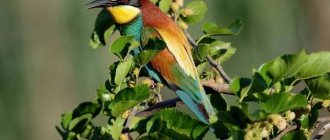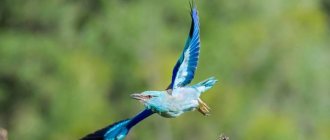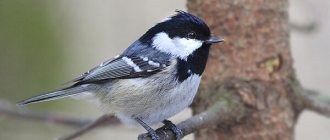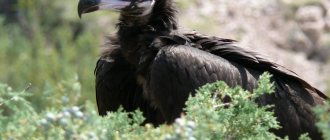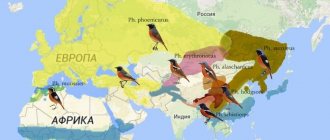Nutrition
The bee-eater feeds on flying insects: wasps, bees, dragonflies, beetles and butterflies. Catches prey on the fly. On occasion, this bird willingly eats honey bees. The bee-eater looks for prey from a high place - a wicker fence, a telegraph pole, a stone or a dry tree branch. Having noticed prey, it immediately rises into the air and catches it. The bird regurgitates the chitinous parts of the insects' covering, its stomach is not able to digest them.
Nubian bee-eater
The Nubian bee-eater differs from many of its fellows by the predominance of a pink tint in color. Due to this, it is also called the purple bee-eater. The bird has a bright pink body, slightly brownish wings and a dark blue head. The long narrow tail is colored brown and can reach 12 centimeters in size.
The purple bee-eater is a migratory bird, but it moves only within Africa. In spring and summer it lives in the northern and southern tropics, in winter it flies closer to the equator. Bee eaters are often seen perched on antelopes, cows and other animals. This is how they look out for prey, and at the same time eat annoying parasites.
Lifestyle
The European bee-eater is a gregarious bird, nesting in colonies numbering from several tens to several thousand individuals. During the nesting period, family groups are formed in them with one or more young birds that have not reached sexual maturity, the so-called “helpers”. Together they dig holes, build nests, raise chicks and even fly south, remaining one family in the next nesting season. Hundreds of brightly colored bee-eaters in flight are a magnificent spectacle created by nature. Birds describe circles, soar, descend from great heights and sing their sonorous song - “pul-pul-pul”. By joint efforts, a flock of bee-eaters drives away from their nests even such predators as black kites that encroach on their eggs and small chicks.
Green bee-eater
This species of bee-eater lives further south than the European bee-eater. In Russia, it is found in the lower reaches of the Volga, along the shores of the Caspian Sea and in the North Caucasus region. The bird is also common in Kazakhstan, Iran, Afghanistan, Egypt and the Middle East. It settles in steppe, desert and semi-desert areas.
The bird has a bright green coloring on the sides, abdomen, back and upper surface of the wings. The neck is painted a dark brick color, with a small yellow spot. The forehead and the area just under the beak are blue-white.
Reproduction
The European bee-eater nests in burrows at a depth of 1.5 m, which it usually digs in sandy cliffs near water. The male and female on the steep bank with their paws and beaks make an almost horizontal passage 1 to 2 m long. At the end of the tunnel there is a nesting chamber. Before laying eggs, both partners protect the nest from the invasion of other contenders, including fellow members of their colony. The female lays 4-6, and sometimes even 10 white eggs, at intervals of 1-2 days. The parents take turns incubating the eggs. At night, they are usually kept warm by the female, while the male sleeps in a nearby tree. The male brings food to the female, who sits on the eggs. Chicks from the previous brood help the pair build a nest and feed the chicks.
The place in which the nest is located is not lined with anything before the eggs are laid, but soon particles of the chitinous covering of insects rejected by the bird's stomach begin to accumulate in it, from which, over time, a fairly thick litter is formed. The chicks hatch one after another with intervals of several days. They are blind and have no feathers. After a week, their eyes open. Parents and “nannies” feed the chicks with insects. After 4 weeks, the chicks begin to fly. Together with their parents and their helpers, they spend several days near the nest, and rest and sleep in trees. Birds feed their chicks for about 3 more weeks.
Description and features
The bee-eater is a small, bright bird of the bee-eater family. This family of heavenly inhabitants is recognized as the most beautiful in Europe. And not without reason. It’s hard not to admire the color of the bee-eater. Feathers are painted in red, green, yellow, blue and their shades.
Each species has its own characteristics of color distribution in plumage. Based on this characteristic, as well as their habitat, more than 20 species of birds are distinguished. Like most birds, males are more beautiful and brighter than females. With age, the color of the feathers becomes brighter. The bee-eater fits in the palm of your hand. Its body length is about 26 cm. The most beautiful bird in Europe weighs from 20 to 50 grams.
At the same time, the baby needs 40 grams of food per day! A distinctive feature of bee-eaters is their beak. It is long in comparison with the body, slightly curved. The beak is the main hunting tool for most birds. That is why lovers of eating insects have developed such an elegant tool during evolution.
Bee-eaters got their name from their characteristic call: “Schur-Schur.” Brightly colored birds are often considered symbols of good luck. The bee-eater is no exception. In many countries where it is not considered an apiary destroyer, meeting a bright bird brings good luck, according to popular belief.
Such a country in Europe is France. And in Egypt and on the island of Crete, not only an encounter with bee-eating bee-eater , but also cooking it for food is considered a good sign. People who practice this argue that if you also eat a lucky sign, then happiness will increase to a greater extent.
Did you know that...
In the nesting chamber of bee-eaters, many remains of the chitinous coverings of insects are found, which the bird’s body does not assimilate.
- Bee-eaters living in tropical Africa form groups with a very interesting social structure. These are one of the most developed bird communities.
- In Africa, bee-eaters often use abandoned aardvark burrows as a nest.
- All species of bee-eaters usually live in small groups - a parent pair, one or more younger birds that have not reached sexual maturity. A family can have up to 12 members.
- The bee-eater occasionally nests in Central Europe. In 1990, more than 12 pairs of European bee-eaters nested in Germany (Baden-Württemberg).
- To feed itself and its chicks, the bee-eater must catch about 225 insects daily.
European bee-eater
The golden bee-eater winters in India and Africa. In spring, it flies to Europe, western Asia and even North America. The bird is found in Moldova, Ukraine, and Belarus. On the territory of Russia, the upper limit of its range passes through the Tambov region.
Bee eaters reach up to 28 centimeters in length. Their abdomen is painted turquoise, their throat is yellow, and their head and back are brick. There is a very light, almost white spot above the beak, and a thin black stripe adorns the neck. Adults are much brighter and darker than young animals, and they also have a longer tail, the size of which can be half the length of the body.
Chickens
Chickens are birds that rarely eat bees, since breeding farms are usually located in different places. Birds meet insects only when wintering in the same room. Chickens enjoy feasting on lethargic, half-asleep individuals. For protection, you will need to enclose the hives with plastic mesh to block access.
Based on observations, it has been established that adult chickens and hens walk between the hives and eat drones, rarely touching the workers. The bird usually catches males expelled from the bee colony. If the beekeeper needs to clear the foundation, it is recommended to simply lay the leaves on the birds, who will immediately peck the drone baby. This will make it easier to get clean wax. Therefore, when located in an apiary, more benefits come from chickens than harm.
Tit
Tits are a large group of birds with similar biological characteristics. In Russia, Europe, and the Middle East, the great tit is more common. The typical habitat is deciduous or mixed forests, near which there are open spaces, forest edges, lakes or rivers.
Appearance - a bird with beautiful plumage, distinguished by a yellow belly, along which runs a black stripe. The color on top of the head is black with a blue tint, and the cheeks are pure white. Average dimensions – length 14–16 cm, weight 15–20 g, wing opening – 23–25 cm.
The diet of tits is varied. Food includes caterpillars, beetles, flies, midges, cockroaches, dragonflies, ants and bees. Dangers for beekeepers:
- luring insects out of houses during wintering by tapping with their beaks;
- disruption of the smooth course of hibernation - bees get sick and die from regular disturbance;
- destruction of bee houses made of polystyrene foam.
Protecting bees from the negative influence of tits consists of securing a ceiling or veranda made of slats near the entrance. The design will protect the bee colony from the loud sounds of birds knocking on the hive.
Tits provide benefits by eating dead, old or sick insects, spiders, and pests. Summer is considered a low-risk period, since there is a lot of other food as food (mosquitoes, aphids, dragonflies, ticks).
Keeping at home
Heat-loving, parrot-like bee-eaters often attract lovers of exotic animals. But even experienced breeders hesitate to purchase a bee-eater as a poultry. It is extremely difficult to maintain, both in terms of arranging an enclosure and in terms of taming it.
They require a lot of space; the cage must allow them to fly at least sometimes. During cold spells, they must be moved to a warm place or the air in the enclosure must be heated to a temperature above +10 degrees.
Adult bee-eaters have difficulty getting used to captivity and interaction with humans, experiencing significant stress. Therefore, chicks are always chosen to keep the house. In addition, birds are very selective in food. They feel best when they catch their own food. To do this, beetles and other insects can be released into the enclosure (if it is made of glass). The food must be alive; bee eaters do not like dead food or special food for birds. They are usually fed with crickets, beetles, various caterpillars, eggs and bloodworms.
Protecting your apiary from bee-eaters
The most common ways to protect beekeeping are:
- Electronic repeller that reproduces the sounds of birds of prey. The essence of his work is that he periodically makes sounds through a loudspeaker with the cries of predators. With its help, not only birds that eat bees are scared away from hives, but also rodents (sorry, it doesn’t work on ants).
- Place shiny and reflective objects around the perimeter of the area or on the crowns of nearby trees. Such items can be discs, audio cassette tapes, or New Year's tinsel.
- Loud sounds. This method will not help get rid of birds for a long time, but you can still periodically make the sound of firecrackers, also knock on a basin, pan, etc.
- A brutal but effective method is to kill several birds and hang their carcasses near the apiary. The main thing is to hang it so that cats and dogs cannot get to the carcasses, as they might eat them.
- Destroy the nests. An effective method, especially when it comes to bee-eaters. It is the golden bee-eater that causes the greatest damage to the apiary. Perhaps people who are far from beekeeping will not understand you and will reproach you for this. Use the services of strangers, for example, neighbor boys. The bee-eater's nest is most often found in tree hollows.
- Hang strips of red fabric. It's not a fact that it will work, but it's worth a try.
- Transport the hive. If birds are seen eating bees near the beekeeping facility, the bee hives will have to be moved to another location. This option should be considered in advance.
There are other interesting ways that will help get rid of annoying birds that eat bees and divert their attention from bee houses. This is especially true for tits:
- Glue the mirror to the tap hole. It works simply: when a tit sits on a hive near the entrance, it sees its reflection and, frightened, flies away.
- Place an inclined board near the hive. It is not very comfortable for the titmouse to sit on an inclined plane and it is more difficult to get to the entrance.
- Install the grid. A kind of mesh cap is put on the hive, which prevents birds from entering.
- Feeding. Another unusual method, the essence of which is that feeders are installed near the apiary. You constantly need to add crumbs of bread, grain or dead bees (if any) to them. Then bee-eaters will not need to fly up to the hives and hunt their inhabitants.
Radical measures include shooting and poisoning. But this is not always legal. For example, the golden bee-eater is listed in the Red Book, therefore, according to the law, it cannot be killed.
A popular natural method of control is the use of predators. If bee-eating birds are frequent visitors, get a cat to scare them away. True, we don’t know how to explain to a cat that there is no need to go into the hive. But the hive will explain to her.
Attention ! It is worth remembering that honey bees have other enemies: spiders, mice, frogs, and predatory wasps. The same methods are used to combat them.
One of our readers, S. Gaydamak, in a commentary to this article said that he uses a device called “Sapsan-3” to scare away bee-eating birds from the apiary. I looked for a description of this repeller and here are 2 videos. The first with a detailed description of the device and its operating modes, and the second with field tests. True, in the video it’s not an apiary, but just a private plot, but I think it doesn’t play a special role. The main thing is that the Sapsan-3 bird repeller works properly. Let's look:
Video No. 1 Bird repeller review:
Video No. 2 Does the bird repellent device cope with its task:
What can I say as a result: Sapsan-3 works. But if he yells constantly throughout the day, he might go crazy. Not only the birds will scatter, but also the neighbors. Especially if you don’t live in the apiary yourself, but come every 3-4 days to check the evidence.
Finding such a device on sale is not difficult
If you don’t plan to spend money on an electronic bird repeller yet, here’s a simpler and cheaper way: stretch tapes from old video cassettes onto the hives. When the wind blows, they not only flutter and hum and rustle, but also give off a great glare, which greatly interferes with the bee-eater's hunting. See for yourself:
As for kites imitating birds of prey, it’s even simpler. Our brothers from the Middle Kingdom have already taken care of this.
At the moment, this is not the only model; if you look at similar products from other sellers, you will see other colors and even plastic stuffed animals of predators, for example an owl with a rotating head.
Another useful thing is anti-bird spikes
I think the purpose of the spikes is clear without additional description. The main thing is not to sit on them yourself. If you rummage through similar products, you can find analogues of Sapsan-3, but with a motion sensor and solar batteries. True, there is a suspicion that it will not work on nimble bee-eaters; this is more likely from larger and less agile ones, such as crows and chickens. There are no good reviews. A dark horse, in short.
Feathered pests
The bee-eater is a beautiful and unusual bird that can bring a lot of benefits by eating locusts and butterflies and beetles that are dangerous to gardens. But among the people it is better known as a bee killer. One bee-eater can eat up to a thousand insects per day. The bird hunts in flocks and, by making “raider raids” on an apiary, can significantly cripple a beekeeper’s home business.
In the 40s of the 20th century, newspapers called for mercilessly dealing with birds by shooting them or filling up their holes. Today, the bee-eater has become a valuable biological specimen. It is included in the Red Books of Belarus, Ukraine, and many regions of Russia, so drastic measures to combat it are contraindicated.
Modern beekeepers deal with feathered pests in other ways. If a colony of bee-eaters is found near the apiary, the hives are simply moved to another area, away from the problems. A flock of bee eaters can be scared away by a bird of prey, for example, a hobby falcon, which hunts them. Of course, not everyone is ready to have such a serious pet, but to ward off the bee-eater from the apiary, all you need to do is turn on a recording of the predator’s voice.
Migratory or wintering
Among the shchur there are both migratory, nomadic and sedentary populations. In each specific region, the migratory behavior of the bee-eaters depends on climatic conditions and the availability of food. In cold winters, pike perch can move south of their usual habitats, but they do not fly far.
Where does it live?
— Advertising —
Shchurs are typical forest dwellers; they live over a vast territory of Asia, Europe and America. To live, these birds choose forests and copses, deciduous and mixed, but always near rivers or other bodies of water, as they are very fond of water treatments.
Bee-eaters do not like to move on the ground, so tall trees are reliable protection for their nesting and everyday life.
Kinds
The genus of bee-eater includes two species: common and rhododendron bee-eater, which are identical in plumage color.
The Rhododendron bee-eater differs from its relative in its smaller size (up to 20 cm in length) and distribution area. This songbird is native to China, Tibet, Burma, Bhutan and Nepal. The species got its name because of its favorite habitats - forest edges with thickets of rhododendron and juniper.
VIDEO: Scaring birds away from hives
Sources
- https://queenbee.ru/pchelovodstvo/ptitsy-pcheloedy-kak-zashhitit-svoyu-paseku-ot-razoreniya
- https://FB.ru/article/426863/ptitsa-pcheloed-opisanie-sreda-obitaniya-foto
- https://givotniymir.ru/shhurka-ptica-obraz-zhizni-i-sreda-obitaniya-shhurki/
- https://ru.wikipedia.org/wiki/%D0%97%D0%BE%D0%BB%D0%BE%D1%82%D0%B8%D1%81%D1%82%D0%B0%D1 %8F_%D1%89%D1%83%D1%80%D0%BA%D0%B0
- https://NatWorld.info/zhivotnye/zolotistaya-shhurka-pcheloedka
- https://med-pochtoi.ru/pchelovodstvo/ptitsy-kotorye-edyat-pchel-nazvanie-opisanie-foto-kak/
- https://mirpchely.ru/pchelovodstvo/paseka/pticy-pcheloedy
- https://truehunter.ru/478666a-kakie-ptitsyi-edyat-os-spisok
- https://medovoemesto.ru/poleznoe/kakie-pticy-edyat-pchel.html
- https://heaclub.ru/pticy-kotorye-edyat-pchel-nazvanie-opisanie-foto-kak-zashhitit-paseku-ot-ptic-poedayushhih-pchel
[collapse]
What does it eat?
— Advertising —
Shuras are granivorous birds and mainly feed on seeds of deciduous and coniferous trees, their buds and shoots, and berries. They also add a small amount of insects to their diet, especially in winter (beetles, their larvae, butterflies in suspended animation). Chicks also need animal food, so their parents feed them insects.
Shchurs are very fond of eating juniper and rowan berries, and in the eastern regions - pine nuts.
